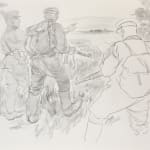Mindaugas Lukošaitis Lithuanian, b. 1980
Rezistencija 2 (17 dalių serija) / Resistance 2 (series of 17 parts), 2019
Pieštukas, popierius / Pencil on paper
21 x 30 cm
Further images
-
(View a larger image of thumbnail 1
)

-
(View a larger image of thumbnail 2
)

-
(View a larger image of thumbnail 3
)

-
(View a larger image of thumbnail 4
)

-
(View a larger image of thumbnail 5
)

-
(View a larger image of thumbnail 6
)

-
(View a larger image of thumbnail 7
)

-
(View a larger image of thumbnail 8
)

-
(View a larger image of thumbnail 9
)

-
(View a larger image of thumbnail 10
)

-
(View a larger image of thumbnail 11
)

-
(View a larger image of thumbnail 12
)

-
(View a larger image of thumbnail 13
)

-
(View a larger image of thumbnail 14
)

-
(View a larger image of thumbnail 15
)

Mindaugas Lukošaitis (b. 1980, Lithuania) is an artist mostly known for his drawings, but his works also include sculptures and objects. He graduated from the Sculpture Department at the Vilnius...
Mindaugas Lukošaitis (b. 1980, Lithuania) is an artist mostly known for his drawings, but his works also include sculptures and objects. He graduated from the Sculpture Department at the Vilnius Academy of Arts in 2003.
His artworks demonstrate the power of vision and imagination that allows having a sharper look at topics such as history, the relevance of post-war resistance, the search for identity, and the spirit of patriotism - both in history as well as in everyday life. The artist tends to rely on the classical, academic drawing technique, where a pencil is used for shading and outlining. However, his approach to academic drawing is unique: Lukošaitis draws “his own realism”, without using models or pictures.
Another important aspect of Lukošaitis’s work is its non-historicalness. The artist draws strange uncanny pictures of isolated objects and nature-like forms, or depicts imagery of unrealised ideas. These drawings are created not to be contextualised outside themselves but to be understood as free products of creative inspiration or realisations of the sketching practice in drawing.
His artworks demonstrate the power of vision and imagination that allows having a sharper look at topics such as history, the relevance of post-war resistance, the search for identity, and the spirit of patriotism - both in history as well as in everyday life. The artist tends to rely on the classical, academic drawing technique, where a pencil is used for shading and outlining. However, his approach to academic drawing is unique: Lukošaitis draws “his own realism”, without using models or pictures.
Another important aspect of Lukošaitis’s work is its non-historicalness. The artist draws strange uncanny pictures of isolated objects and nature-like forms, or depicts imagery of unrealised ideas. These drawings are created not to be contextualised outside themselves but to be understood as free products of creative inspiration or realisations of the sketching practice in drawing.



















